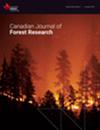北方针叶林粗木屑腐烂期、树种期和林分发育期真菌群落动态
IF 1.5
3区 农林科学
Q2 FORESTRY
引用次数: 0
摘要
真菌是北方森林中粗木质碎屑(CWD)腐烂的主要原因,在营养循环和碳储存中发挥着重要作用。我们使用α和β多样性指标以及CWD的物理和化学性质,比较了3个树种(颤抖白杨[Populus tremuloides]、黑云杉[Peacea mariana]和杰克松[Ppinus banksiana])、5个腐朽类别和2个林分发育阶段的真菌群落组合,这在安大略省北方林区林分置换干扰后的时间上有所不同。我们从6个独立的林分中取样了180个单独的CWD原木,每个物种3个重复,每个地点的腐朽等级组合。使用标记DNA的高通量测序,我们发现真菌群落结构在树种、腐朽阶段和林分年龄之间存在显著差异。真菌多样性在腐烂等级4 CWD中最高。我们发现,Mn和K浓度、总碳、C/N比、N/P比和水分含量是CWD物种和/或腐烂阶段真菌组成的重要预测因素。这项研究表明,考虑枯木数量和质量的森林管理指南将通过干扰后林分的发展支持更广泛的真菌物种和群落。本文章由计算机程序翻译,如有差异,请以英文原文为准。
Fungal community dynamics in coarse woody debris across decay stage, tree species, and stand development stage in northern boreal forests
Fungi are primary agents of coarse woody debris (CWD) decay in boreal forests, playing an essential role in nutrient cycling and carbon storage. We compared fungal community assemblages using alpha and beta diversity metrics, and physical and chemical properties of CWD across 3 tree species (trembling aspen [Populus tremuloides], black spruce [Picea mariana], and jack pine [Pinus banksiana]), 5 decay classes, and 2 stand development stages, differing in time-since-stand replacing disturbance in Ontario’s boreal forest region. We sampled 180 individual CWD logs from 6 independent stands, with 3 replicates per each species × decay class combination at each site. Using high-throughput sequencing of marker DNA, we found that fungal community structure significantly differed across tree species, decay stage, and stand age. Fungal diversity was highest in decay class 4 CWD. We found that Mn and K concentrations, total carbon, C/N ratio, N/P ratio, and moisture content were important predictors of fungal composition across CWD species and/or decay stage. This study suggests that forest management guidelines that consider both deadwood quantity and quality will support a broader range of fungal species and communities through post-disturbance stand development.
求助全文
通过发布文献求助,成功后即可免费获取论文全文。
去求助
来源期刊
CiteScore
4.20
自引率
9.10%
发文量
109
审稿时长
3 months
期刊介绍:
Published since 1971, the Canadian Journal of Forest Research is a monthly journal that features articles, reviews, notes and concept papers on a broad spectrum of forest sciences, including biometrics, conservation, disturbances, ecology, economics, entomology, genetics, hydrology, management, nutrient cycling, pathology, physiology, remote sensing, silviculture, social sciences, soils, stand dynamics, and wood science, all in relation to the understanding or management of ecosystem services. It also publishes special issues dedicated to a topic of current interest.

 求助内容:
求助内容: 应助结果提醒方式:
应助结果提醒方式:


